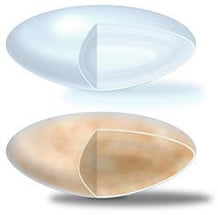Your eye has a clear lens through which light passes, allowing you to see. When the lens loses its transparency, the cloudy tissue that develops is known as a cataract.
Cataracts cause progressive, painless loss of vision. The lens clouds naturally as we age, so people over the age of 65 usually see a gradual reduction of vision.

No one is exactly sure what causes cataracts. In younger people they can result from an injury, certain medications, or illnesses such as diabetes. Prolonged exposure to ultraviolet light may also play a role in the formation of cataracts. Studies have also shown that people who smoke cigarettes have a higher risk of developing cataracts than non-smokers.
Although cataracts usually develop without apparent pain, some indications that a cataract may be forming are:
- Blurred or hazy vision
- Double vision
- Poor vision in bright light
- Seeing halos around lights
- Yellowish tinged vision
- Night vision difficulty
If visual impairment interferes with your ability to read, work, or do the things you enjoy then you will want to consider cataract surgery. Surgery is the only proven means of effectively treating cataracts. Cataract surgery is a relatively painless and is one of the most frequently performed procedures. It has a very high success rate and more than 90 percent of cataract surgery patients regain useful vision.
Cataract Surgery
We perform a minimally invasive, no-stitch cataract surgery called phacoemulsification (“phaco”) surgery. First, the eye is numbed with anesthesia. Then a tiny incision is made in the eye to make room for a small ultrasonic probe. This probe breaks up, or emulsifies, the cloudy lens into tiny pieces.
After the cloudy lens has been removed, a new artificial lens is implanted in the eye. With the recent advance of foldable IOLs (intraocular lenses), artificial lenses can be implanted through the same small incision from the phaco procedure.
Cataract Lenses (IOLs)
There are a wide range of replacement lenses available to cataract patients, each offering different advantages for your post-surgery vision. The most effective lens depends on each patient’s individual preferences and goals for their vision. The latest lenses help eliminate the need for glasses or contacts after cataract surgery, providing convenient, effective results for your specific vision conditions.
Multifocal IOLs
In the past, cataract lenses were only able to correct distance vision, often leaving patients with the need for reading glasses. Multifocal IOLs offer patients freedom from glasses after cataract surgery by improving vision at all distances and at any time of day. These lenses can quickly change focus to accommodate your vision needs. Up to 80 percent of patients do not need to rely on glasses with multifocal IOLs.
Accommodative IOLs
Accommodative IOLs offer a full range of restored vision for cataract patients. Many people experience a loss of near vision with age and often need to rely on glasses after cataract surgery. Accommodative IOLs such as Crystalens® replace the natural eye’s natural lens and mimics its accommodation capabilities, allowing you to see clearly across a wide range of distances.
Toric IOLs
Toric IOLs are specifically designed for patients with astigmatism. In the past, patients with astigmatism would need eyeglasses or contact lenses even after cataract surgery in order to correct the problem. Toric IOLs such as AcrySof Toric corrects cataracts and astigmatism with just one lens, providing a more convenient and affordable solution to your vision needs.

